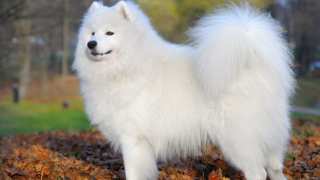Samoyed Breed Details
The Samoyed, a member of the Working group of breeds, has existed as a working animal in Siberia and other cold regions for centuries--but these Spitz dogs are as equally prized for their cheerful demeanors as for their tireless work ethic. These versatile dogs are good both in a work capacity and as a family pet, so Sammies are good for practically everyone (especially those living in colder climates).
A few Samoyed dog facts: they're medium-sized (height at the shoulders averages 21 inches, and weight 45 pounds), with medium- to long-haired, double-layered coats in white and/or various shades of cream. Now for some Samoyed pros and cons:
PROS:
- Loving, playful, and adaptable
- Low to moderate maintenance needs
- Intelligent and intuitive
- Excellent "cold-weather" dogs
- Socialize very well with kids, pets, and strangers alike
- Easily trained
- Fairly good health
CONS:
- Sheds profusely
- May turn destructive if left alone for extended periods
- Daily exercise required
- High prey drive; will instinctively chase other animals
- Frequent barking tendency
- Not suited for hot climates
- Can be very expensive to purchase





